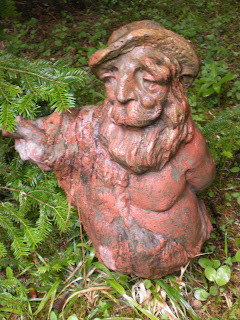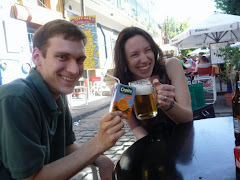
For much of this past week, I was in Ozurgeti, a city in the west of Georgia, working with my fellow, awesome PCVs to host a women's health fair called Celebrating Healthy Women. The first such fair was hosted by volunteers in 2007, and a great group of G9 volunteers hosted a second fair in June 2010 in Rustavi, a city just outside of Tbilisi. These ladies hosted a great event and we in the G10 group wanted to keep CHW going. The G9s gave us lots of tips and advice, shared their contact list of health organizations in Georgia and all came to lend a hand on the day of the fair. We tried our best this Saturday to follow in their footsteps and host our own successful 2011 CHW fair.
Opening of the health fair!

Our main organizer was one of our BSE (Business and Social Entrepreneurship Program, which primarily works with different NGOs in Georgia) volunteers. Lacey, who lives in Ozurgeti (Oz, as she likes to call it) works with an organization that was the main sponsor and cooperating partner for the fair. Lacey (with some help from some other volunteers and me) wrote a grant and received funding through VAST (Volunteer Activities Support and Training, a grant program funded by PEPFAR, the U.S. President's Emergency Plan for AIDS Relief), to put on the fair. We held the fair at Lacey's organization's offices, where we had informational booths set up in the courtyard, presentations going on in the main presentation room and the theater and doctors appointments and consultations being carried out. Lacey's organization also gave us additional funding so that we could purchase give-away items (a no-no, non-reimbursable item under the VAST grant).
While we worked on the Health Fair pretty consistently from January on, the final big push for confirming the participation of organizations, purchasing materials, coordinating doctors to donate their time and services, advertising and pulling everything together took place all May. I went to Oz on Wednesday, lugging lots of stuff and ready to help get even more together. Lacey and I spent one whole day scouring the bazaar to buy soap, toothbrushes and combs to put in giveaway bags (which we planned to use to make sure attending women would fill out our short monitoring forms so we could get a head count and have some basic statistics for the event's final report). We spent another day making our gift bags, folding programs, ordering food and flowers and other necessaries and writing out our opening and closing speeches.
We bought 200 bottles of nail polish...

...and 200 combs

...and 200 toothbrushes and 200 bars of soap

Then we cleaned everything up and packed them into little gift bags

On Saturday the weather was beautiful (a big relief, given the plan to have the informational booths in the courtyard!) and we had 9 great health organizations show up to distribute information and pamphlets and talk to women about their specific health focuses. Six doctors donated their time and expertise to provide free consultations to women about prenatal care, raising healthy children and gynecological issues and to check eyesight and hearing. The presentation topics ranged from HIV/AIDS awareness and statistics, age-related health issues for women, giving self breast-exams, and reproductive health.
Final set up moments

The doctors' appointment signup table was pretty hopping as soon as we opened the doors

One of the informational booths

Doctors' consultations took place in several rooms in the offices

Women checking out the informational booths

We got a huge crowd of other PCVs to help keep order and run the event, and also had a crew of 30 schoolchildren from Ozurgeti who volunteered to help out as well (these kids were great; they are all participants in a youth leadership school that Lacey's organization runs and she held trainings with them ahead of time to teach the kids about the importance of community involvement and volunteering). The student volunteers were really helpful and enthusiastic and seemed to really enjoy getting all of the health information, which was a nice side benefit of their participation.
I staffed the "check your BMI" station for a little while

One of the presentations in the theater

Another presentation in the large presentation room

We were extremely happy about how everything worked out on the organizational front and were prepared for a completely successful event. We didn't get quite the turnout we were hoping for--I think our final count was somewhere around 90 attendees--but those who did come got a lot of useful information and seemed to really enjoy the fair. The concept of a fair is pretty foreign here, so that was clearly a challenge to overcome. Additionally, a lot of people here tend to be pretty afraid of doctors and of receiving bad health news. Lastly, a lot of the topics we covered are pretty difficult to talk about in this conservative culture, so that could have discouraged some from attending. We'll be regrouping and reevaluating the direction the Celebrating Healthy Women fairs should take in the future. For now, though, we're all happy to have finished up and pulled everything off. We'll do our final evaluations and reports after taking a short break to relax.
Me and Lacey, both making ridiculous faces, but the only picture I have on my camera of the two of us at the event. Hooray for a completed project!







































